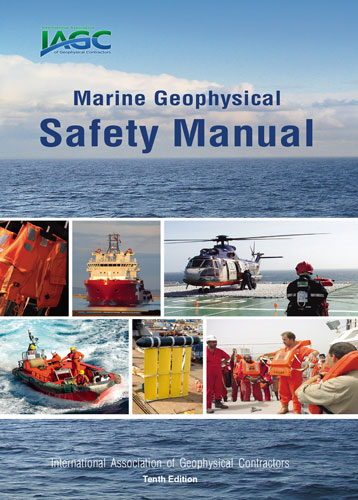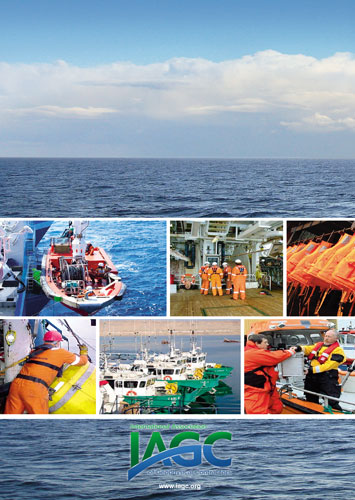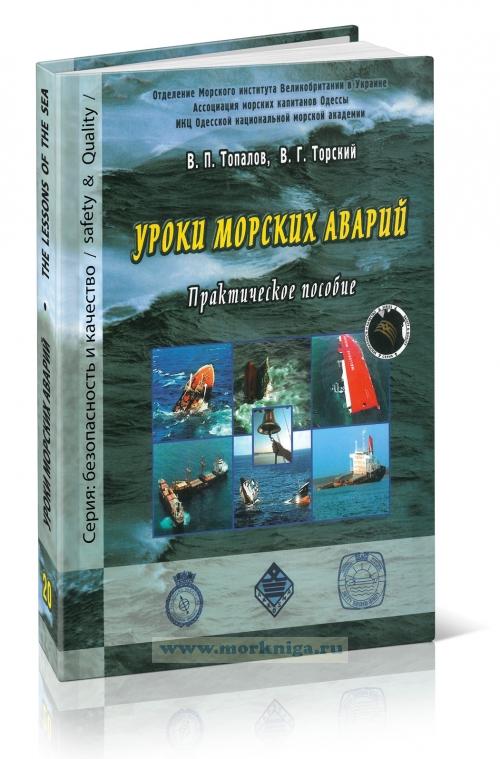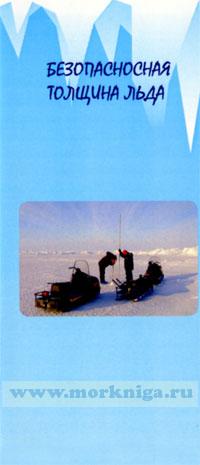Сб с 10 до 16
Marine Geophysical Safety Manual/Руководство по морской геофизической безопасности
Книга на английском языке
Everyone involved in the geophysical industry is accountable to themselves, their families, their fellow workers, their employers and their clients to work in a safe and responsible manner, follow established rules, comply with local regulatory requirements and follow their company's policy.
All personnel should challenge and report all unacceptable HSE situations, incidents, (accidents and near misses), whenever or wherever they occur, to their supervisor.
Always Remember: Common Sense Is Not So Common.
Do not expect others working with and around you to always see potential hazards the same way. All geophysical personnel should work together and communicate their experiences and knowledge to ensure there is a shared perception of the risks.
The quality of the geophysical industry's work is dependent on our skilled and experienced personnel. Accidents deplete this invaluable resource. The IAGC hopes that the use of this manual will lead to greater HSE awareness throughout the industry and improve performance for all operators.
The IAGC encourages all employees to read this manual and to become familiar with its content.
Table of Contents
1 Preface
1.1 Purpose
1.2 Scope
1.3 Definitions
1.4 References
1.5 Acknowledgments
2 HSE management systems
2.1 Basic HSE Training
2.1.1 Minimum Safety Training
2.2 HSE Meetings
2.3 Incident Reporting
2.4 Auditing and Improvement
2.5 General HSE
2.6 Common Knots
2.6.1 Clove Hitch
2.6.2 Round Turn and Two Half Hitches
2.6.3 Bowline
2.6.4 Sheet Shank/Bend
2.6.5 Figure of Eight
3 Human factors
3.1 Improving HSE Performance
3.2 HSE Culture
3.3 Work Observation Programs
3.4 Employee Led HSE Programs
4 Health, hygiene and injury prevention
4.1 Health Risk Assessment (HRA)
4.2 Heat conditions
4.2.1 Heat Rashes
4.2.2 Heat Cramps
4.2.3 Heat Fatigue
4.2.4 Heat Collapse ("Fainting")
4.2.5 Heat Exhaustion
4.2.6 Heat Stroke
4.2.7 Treatment of Heat Stress
4.2.8 Prevention Measures
4.2.9 Fluid Replacement
4.3 Cold Conditions
4.3.1 Wind Chill
4.3.2 Personal Protection
4.3.3 Foods and Liquids
4.3.4 Frostbite
4.3.5 Trench Foot
4.4 Personal Hygiene
4.5 Noise
4.6 Compressed Air
4.7 Electrical
4.8 Chemical
4.9 Biological
4.9.1 Malaria
4.9.2 Sexually Transmitted Diseases (STD)
4.9.3 Blood Borne Pathogens
4.10 Ergonomic
4.10.1 Lifting
4.11 Hours of Work
4.12 Substance Abuse
4.13 Use of Tools
4.14 Working at Heights
4.15 Personal Protective Equipment (PPE)
4.15.1 General
4.15.2 Personal Floatation Devices (PFDs)
4.15.3 Life Jackets/Work Vests
4.15.4 Inflatable Life Jackets
4.15.5 EN PFD Classifications
4.15.6 US Coast Guard PFD Classifications
4.16 Subcontractors and Visitors
5 Seismic operations
5.1 Air Guns and Compressors
5.1.1 Compressed Air Hazards
5.1.2 Explosion Hazards
5.1.3 Air Gun Handling
5.1.4 Compressed Air Injuries
5.2 Towed Seismic Operations
5.2.1 Deployment and Recovery of In-Sea Equipment
5.2.2 In-Sea Repairs and Maintenance
5.2.3 Streamer
5.2.4 Handling of Paravanes / deflectors
5.2.5 Work On Tailbuoys
5.3 Hazardous Materials (HAZMAT)
5.3.1 Cable Oils
5.3.2 Batteries
5.3.3 Storage and Handling of Gasoline
5.3.4 Explosives
5.4 Ocean Bottom Operations
5.4.1 Deployment Operations
5.4.2 Recovery Operations
5.5 Ocean Bottom Nodal Surveys
5.5.1 Deployment Operations
5.5.2 Recovery Operations
5.5.3 Contingency Procedures
5.6 Controlled Source Electromagnetic Survey Operations
5.7 Gravity Measurement
5.8 Magnetic Data Acquisition
5.9 Transition Zone/Telemetry Operations
6 Vessel operations
6.1 General
6.2 Boat Transfers
6.2.1 Boat to Boat
6.2.2 Shore Landings
6.2.3 Personnel Basket Transfer
6.3 Small Boats (Launch and Recovery)
6.4 Environmental Awareness
6.4.1 Waste Management
6.4.2 Hazardous Material Spills
6.4.3 Air Emissions
6.4.4 Marine Mammals and Sea Life
6.5 Security and ISPS Code
6.5.1 In Port
6.5.2 At Sea
6.6 Bunkering
6.6.1 In Port
6.6.2 At Sea
6.7 Electrical Equipment and Wiring
6.8 Lockout/Tagout
6.9 Radio, Radar and Navigation
6.10 Galley
6.11 Engine Room
6.12 Cranes and Lifting Devices
6.12.1 Slings and Lifting Appliances
6.12.2 Webbing Straps
6.12.3 Wire Rope Slings
6.12.4 Signs of Defective Wire Rope Slings
6.13 Welding, Burning and Cutting
6.13.1 General Safe Practices
6.13.2 Acetylene (Gas) Welding and Cutting Tools
6.13.3 Electric Welding and Cutting Tools
6.14 Portable Ladders and Scaffolds
6.15 Chipping and Painting
7 Emergency procedures
7.1 Survival at Sea
7.1.1 Survival
7.1.2 Detection (Colour, Light, Sound, Movement)
7.1.3 Food and Water
7.1.4 Emergency Treatment
7.1.5 Survival Suits
7.2 Emergency Drills
7.2.1 General Rules
7.2.2 Alarm Signals
7.2.3 Fire Drills
7.2.4 Manning Fire Stations
7.2.5 Testing the Fire Pump
7.2.6 Man Overboard Drills
7.2.7 Abandon Ship Drills
7.3 Medical Emergency Evacuation Plan
7.4 Abandon Ship Procedures
7.5 Man Overboard Procedures
7.6 Marine Fire Protection and Fire Procedures
7.7 Fire and Emergency Stations
7.8 Fire and Safety Plan
7.9 Fire Extinguishers
7.9.1 Foam Extinguishers
7.9.2 Class D (Lithium) extinguishers
7.10 Fixed Fire Fighting Systems (Gas Deluge Systems)
7.10.1 Hi-Fog Extinguishing Systems
7.10.2 CO2 and other extinguishing systems
7.10.3 AFFF Deluge System
7.10.4 Halons
7.11 Fixed Detection System
7.12 Disabling of Fire Alarms
7.13 Fire Hoses
7.14 Fire Fighting
8 Helicopters
8.1 General
8.2 Training
8.3 Pre-Flight Preparation
8.3.1 Helicopter Operator provided information
8.3.2 Vessel operator provided information
8.4 Prior to Departure from Helibase
8.5 Enroute to Vessel
8.6 Deck Crew
8.7 Deck Equipment
8.8 Landing on Vessel
8.9 Fuelling Operations
8.10 Prior to Take-Off from Vessel
8.11 After Take-Off
8.12 Emergency Landing
9 First aid





 Руководство по действиям в аварийных ситуациях на судне. Извлечение из МК ПДМНВ, Резолюции 1 и 2
Руководство по действиям в аварийных ситуациях на судне. Извлечение из МК ПДМНВ, Резолюции 1 и 2  Уроки морских аварий. Практическое пособие
Уроки морских аварий. Практическое пособие  Буклет "Безопасная толщина льда"
Буклет "Безопасная толщина льда"